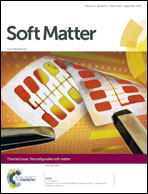Fluid-driven motion of passive cilia enables the layer to expel sticky particles
Abstract
Inspired by marine organisms that utilize active cilia to prevent the biofouling of their surfaces, we use computational and theoretical modeling to determine if passive cilia, which are driven to undulate by an oscillatory shear flow, can be harnessed for antifouling applications. By modeling the oscillating shear flow near a ciliated wall within a channel, we show that the fluid-driven motion of cilia enables the layer to repel adhesive particles away from the surface. Compared to the behavior of the system in a non-oscillating shear, the oscillations also help transport the particles more rapidly along the flow direction. Moreover, the oscillations allow “stickier” particles to be conveyed by the flow relative to the case involving non-oscillatory flow. A simple theoretical model that considers the motion of an adhesive particle interacting with an oscillating, elastic layer captures the behavior observed in the simulations and indicates that the adhesive particle can be repelled away for a wide range of oscillation frequencies. The findings suggest that passive cilia can be used to create self-cleaning surfaces, utilizing oscillations in the flow to prevent the attachment of microparticles and biological cells.

- This article is part of the themed collection: Reconfigurable soft matter

 Please wait while we load your content...
Please wait while we load your content...